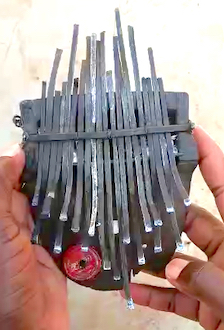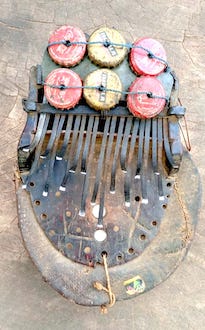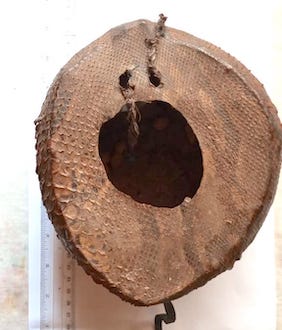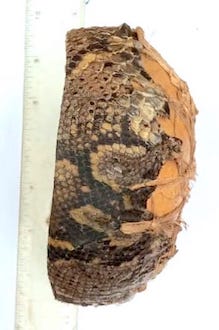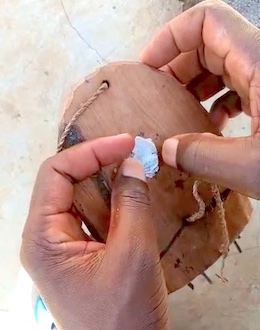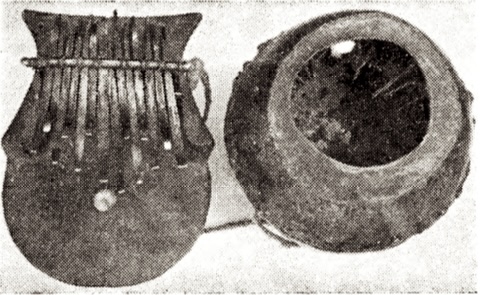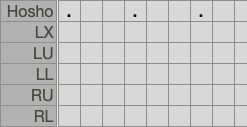Scale degrees are numbered from
1 to
7;
1 being the
reference key of the instrument (which in most cases is the lowest key, as in the picture above).
It is the same as the
Pitch+Octaves.1 notation,
with all octave indication omitted where it can be deduced from the playing area.
Key Overview
The table below shows all keys of the notation, from lowest to highest.
Each row contains all possible keys for that playing area.
Each column contains all keys of the same pitch.
Not all instruments may have keys matching all these notes.
Red notes are
alias names
for the same key, if it can be played with different fingers.
| Hosho | . | | | | | | | | | | | | | | | | | |
| LX | | | | | | | | | | | | | | | | | | 5 |
| LU | | | | | | | | | | | 4 | 5 | 6 | 7 | 1 | 2 | 3 | |
| LL | | 1, | 3, | 4 | | | | 1 | 2 | 3 | | | | | | | | |
| RU | | | | | | | | 1 | | | 4 | 5 | 6 | 7 | 1' | | | |
| RL | | 1 | 3 | 4 | 5 | 6 | 7 | | | | | | | | | | | |
Aliases
The table below lists all alias keys.
Row names are shown in black, cell content in red.
| Key | Alias | Notes |
|---|
| RL1 | LL1, | RL1 key played with left thumb |
| RL3 | LL3, | RL3 key played with left thumb |
| RL4 | LL4 | RL4 key played with left thumb |
Same numbers as the
Pitch.1 notation, but full octave indication.
Key Overview
The table below shows all keys of the notation, from lowest to highest.
Each row contains all possible keys for that playing area.
Each column contains all keys of the same pitch.
Not all instruments may have keys matching all these notes.
Red notes are
alias names
for the same key, if it can be played with different fingers.
| Hosho | . | | | | | | | | | | | | | | | | | |
| LX | | | | | | | | | | | | | | | | | | 5' |
| LU | | | | | | | | | | | 4 | 5 | 6 | 7 | 1' | 2' | 3' | |
| LL | | 1, | 3, | 4, | | | | 1 | 2 | 3 | | | | | | | | |
| RU | | | | | | | | 1 | | | 4 | 5 | 6 | 7 | 1' | | | |
| RL | | 1, | 3, | 4, | 5, | 6, | 7, | | | | | | | | | | | |
Aliases
The table below lists all alias keys.
Row names are shown in black, cell content in red.
| Key | Alias | Notes |
|---|
| RL1, | LL1, | RL1, key played with left thumb |
| RL3, | LL3, | RL3, key played with left thumb |
| RL4, | LL4, | RL4, key played with left thumb |
This is similar to the
Pitch.1 notation,
just assigning
4 as the reference key's scale degree.
Key Overview
The table below shows all keys of the notation, from lowest to highest.
Each row contains all possible keys for that playing area.
Each column contains all keys of the same pitch.
Not all instruments may have keys matching all these notes.
Red notes are
alias names
for the same key, if it can be played with different fingers.
| Hosho | . | | | | | | | | | | | | | | | | | |
| LX | | | | | | | | | | | | | | | | | | 1 |
| LU | | | | | | | | | | | 7 | 1 | 2 | 3 | 4 | 5 | 6 | |
| LL | | 4, | 6, | 7 | | | | 4 | 5 | 6 | | | | | | | | |
| RU | | | | | | | | 4 | | | 7 | 1 | 2 | 3 | 4' | | | |
| RL | | 4 | 6 | 7 | 1 | 2 | 3 | | | | | | | | | | | |
Aliases
The table below lists all alias keys.
Row names are shown in black, cell content in red.
| Key | Alias | Notes |
|---|
| RL4 | LL4, | RL4 key played with left thumb |
| RL6 | LL6, | RL6 key played with left thumb |
| RL7 | LL7 | RL7 key played with left thumb |
Same numbers as the
Pitch.4 notation, but full octave indication.
Key Overview
The table below shows all keys of the notation, from lowest to highest.
Each row contains all possible keys for that playing area.
Each column contains all keys of the same pitch.
Not all instruments may have keys matching all these notes.
Red notes are
alias names
for the same key, if it can be played with different fingers.
| Hosho | . | | | | | | | | | | | | | | | | | |
| LX | | | | | | | | | | | | | | | | | | 1'' |
| LU | | | | | | | | | | | 7 | 1' | 2' | 3' | 4' | 5' | 6' | |
| LL | | 4, | 6, | 7, | | | | 4 | 5 | 6 | | | | | | | | |
| RU | | | | | | | | 4 | | | 7 | 1' | 2' | 3' | 4' | | | |
| RL | | 4, | 6, | 7, | 1 | 2 | 3 | | | | | | | | | | | |
Aliases
The table below lists all alias keys.
Row names are shown in black, cell content in red.
| Key | Alias | Notes |
|---|
| RL4, | LL4, | RL4, key played with left thumb |
| RL6, | LL6, | RL6, key played with left thumb |
| RL7, | LL7, | RL7, key played with left thumb |
